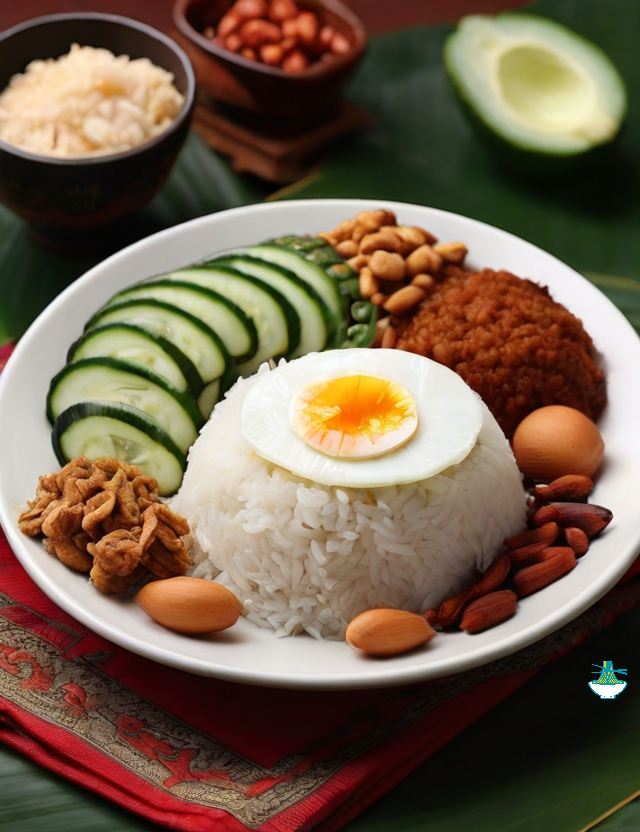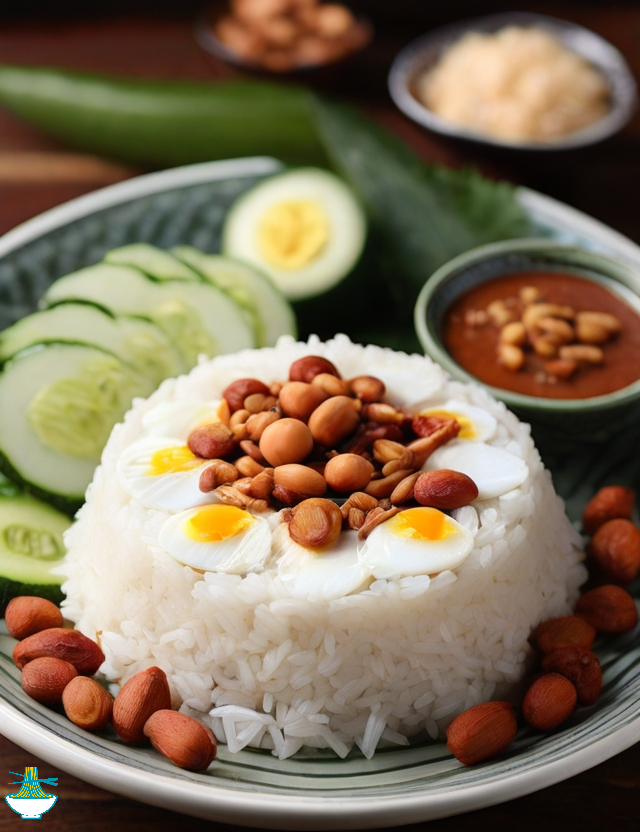Embark on a culinary journey to the heart of Brunei with our exquisite recipe for Nasi Lemak. Brunei, a tiny yet culturally rich nation on the island of Borneo, brings forth a distinctive twist to this beloved Southeast Asian dish. Nasi Lemak, a fragrant coconut rice dish served with an array of tantalizing accompaniments, takes on a uniquely Bruneian flavor profile, reflecting the nation's diverse culinary influences.
In this recipe, we will guide you through the art of creating Brunei Nasi Lemak, where every aromatic grain of coconut-infused rice is a testament to the country's culinary prowess. With a perfect blend of sweetness, spiciness, and savory richness, this dish captures the essence of Brunei's gastronomic heritage. Join us as we uncover the secrets behind crafting this delectable Bruneian classic that promises to transport your taste buds to the enchanting flavors of this Southeast Asian gem.
Ingredients:
For Coconut Rice:
- 2 cups jasmine rice
- 1 ½ cups coconut milk
- 1 cup water
- 1 pandan leaf, tied in a knot (optional)
- 1 teaspoon salt
For Sambal (Chili Paste):
- 10-12 dried red chilies, soaked in hot water
- 3 cloves garlic
- 1 medium-sized onion
- 2 tablespoons tamarind paste
- 2 tablespoons palm sugar or brown sugar
- Salt to taste
- 2 tablespoons vegetable oil
For Accompaniments:
- 1 cup anchovies, cleaned and fried until crispy
- 1 cup peanuts, roasted
- 4 boiled eggs, halved
- 1 cucumber, sliced

Instructions:
Coconut Rice: a. Rinse the jasmine rice until the water runs clear. b. In a rice cooker or a pot, combine rice, coconut milk, water, pandan leaf, and salt. c. Cook the rice according to your rice cooker instructions or bring it to a boil, then reduce heat to low, cover, and simmer until the rice is tender and has absorbed the liquid. d. Once cooked, fluff the rice with a fork and let it sit, covered, for an additional 5 minutes to allow it to steam.
Sambal (Chili Paste): a. In a blender, combine soaked dried chilies, garlic, onion, tamarind paste, palm sugar, and salt. b. Blend until you get a smooth paste. c. In a pan, heat vegetable oil and sauté the paste over medium heat until it becomes fragrant and the oil begins to separate. d. Adjust seasoning if necessary, and set aside.
Serving: a. Arrange the coconut rice on a serving plate. b. Place fried anchovies, roasted peanuts, boiled eggs, and sliced cucumber around the rice. c. Drizzle the sambal over the rice or serve it on the side. d. Optionally, garnish with additional fried shallots or fresh herbs for added flavor.
Enjoy your Brunei Nasi Lemak! Dive into the layers of flavors and textures as you mix the fragrant coconut rice with the spicy sambal, crunchy anchovies, and peanuts. This Bruneian twist on Nasi Lemak is a delightful symphony of tastes that will transport you to the vibrant culinary landscape of Brunei.
Nutritional Values
Providing precise nutritional values can be challenging due to variations in specific products and preparation methods. However, here are approximate nutritional values for the listed ingredients based on standard serving sizes and general nutritional information:
Jasmine Rice (2 cups):
- Calories: 400
- Carbohydrates: 88g
- Protein: 8g
- Fat: 1g
- Fiber: 2g
Benefit: A good source of complex carbohydrates, providing sustained energy. Also, it contains small amounts of protein and fiber.
Coconut Milk (1 ½ cups):
- Calories: 750
- Carbohydrates: 15g
- Protein: 7g
- Fat: 75g
- Fiber: 3g
Benefit: Adds a rich, creamy texture and a unique flavor. Contains healthy fats and provides a source of medium-chain triglycerides (MCTs).
Water (1 cup):
- No significant nutritional value.
Benefit: Essential for hydration; no significant nutritional value but aids in cooking and texture.
Pandan Leaf (1 leaf, optional):
- Minimal caloric and nutritional impact.
Benefit: Infuses a subtle, aromatic flavor into the rice. Pandan is also believed to have antioxidant and anti-inflammatory properties.
Salt (1 teaspoon):
- Calories: negligible
- Sodium: approximately 2,300mg
Benefit: Enhances flavor and balances the dish. However, moderation is key as excessive salt intake should be avoided for health reasons.
Dried Red Chilies (10-12 chilies):
- Calories: 30
- Carbohydrates: 6g
- Protein: 1g
- Fat: 1g
- Fiber: 2g
Benefit: Adds spice and heat to the sambal. Contains capsaicin, which may have metabolism-boosting and anti-inflammatory properties.
Garlic (3 cloves):
- Calories: 15
- Carbohydrates: 3g
- Protein: 1g
- Fat: negligible
Benefit: Contributes to the savory flavor profile. Garlic is known for potential immune-boosting and cardiovascular benefits.
Onion (1 medium-sized):
- Calories: 45
- Carbohydrates: 11g
- Protein: 1g
- Fat: negligible
Benefit: Adds sweetness and depth to the sambal. Onions are a good source of vitamins and antioxidants.
Tamarind Paste (2 tablespoons):
- Calories: 40
- Carbohydrates: 10g
- Protein: negligible
- Fat: negligible
Benefit: Provides a tangy flavor to the sambal. Tamarind is rich in antioxidants and may have anti-inflammatory properties.
Palm Sugar or Brown Sugar (2 tablespoons): -
- Calories: 90
- Carbohydrates: 24g
- Protein: negligible
- Fat: negligible
Benefit: Adds sweetness to balance the spiciness. While high in calories, it contains some essential minerals.
Vegetable Oil (2 tablespoons): -
- Calories: 240
- Fat: 28g
Benefit: Used for cooking the sambal and adds richness. Provides healthy fats, including unsaturated fats.
Anchovies (1 cup, fried): -
- Calories: 500
- Protein: 60g
- Fat: 28g
Benefit: Contributes a salty and umami flavor. Anchovies are a good source of omega-3 fatty acids and protein.
Peanuts (1 cup, roasted): -
- Calories: 840
- Carbohydrates: 24g
- Protein: 36g
- Fat: 72g
- Fiber: 12g
Benefit: Adds crunch and nuttiness. Peanuts are rich in protein, healthy fats, and various nutrients.
Boiled Eggs (4 eggs): -
- Calories: 320
- Protein: 28g
- Fat: 20g
- Carbohydrates: 4g
Benefit: Adds protein and creaminess. Eggs are a complete protein source and provide essential vitamins and minerals.
Cucumber (1 cucumber, sliced): -
- Calories: 45
- Carbohydrates: 11g
- Protein: 2g
- Fat: negligible
- Fiber: 2g
Benefit: Adds freshness and a cooling element. Cucumbers are low in calories and a good source of hydration.
These values are approximate and can vary based on specific brands, preparation methods, and serving sizes. It's advisable to refer to specific product labels and use a nutrition calculator for more accurate information based on your recipe and ingredient choices.


Comments